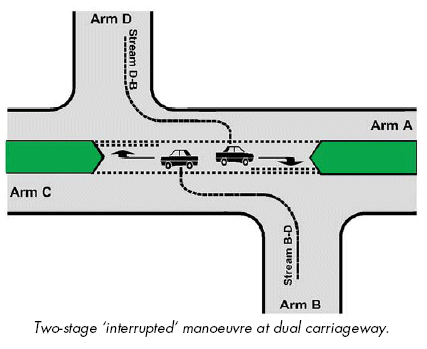When modelling a staggered crossroads on a dualled section of road, does the width of the central reserve has any bearing on PICADY understanding of the manoeuvre and that vehicles turning from B to A can store in the central reserve?
The original research that defines what PICADY does contains the following paragraphs:
“At dual-carriageway sites right-turning minor road vehicles can interrupt their manoeuvre at the central reserve. In principal this might to some extent ‘decouple’ the traffic interactions on either side of the major road carriageway and weaken the dependence of the max flow of B-A on C-A traffic. In practice, however, it has not proved possible to detect a significant difference in the traffic interactions determining the capacity of the single- and dual-carriageway sites.”
“The width of the central reserve did influence the B-A capacity, but independently of the C-A traffic, simply modifying the saturation flow.”
“At busy dual-carriageway sites in peak periods … the benefits of increasing the central reserve width are about half of those of increasing the carriageway width by the same amount.”

So, increasing the central reserve width makes all relevant manoeuvres easier for drivers, in a similar way that widening the road in general would. But it is NOT the case that PICADY explicitly models vehicles as stopping in the central reserve.
Of course, if you increase the stagger distance then eventually the junction would be better described as two linked T-junctions. Using PICADY 9 this can be modelled using Lane Simulation mode, and this WILL model the separate components of the journey from one minor arm to another.